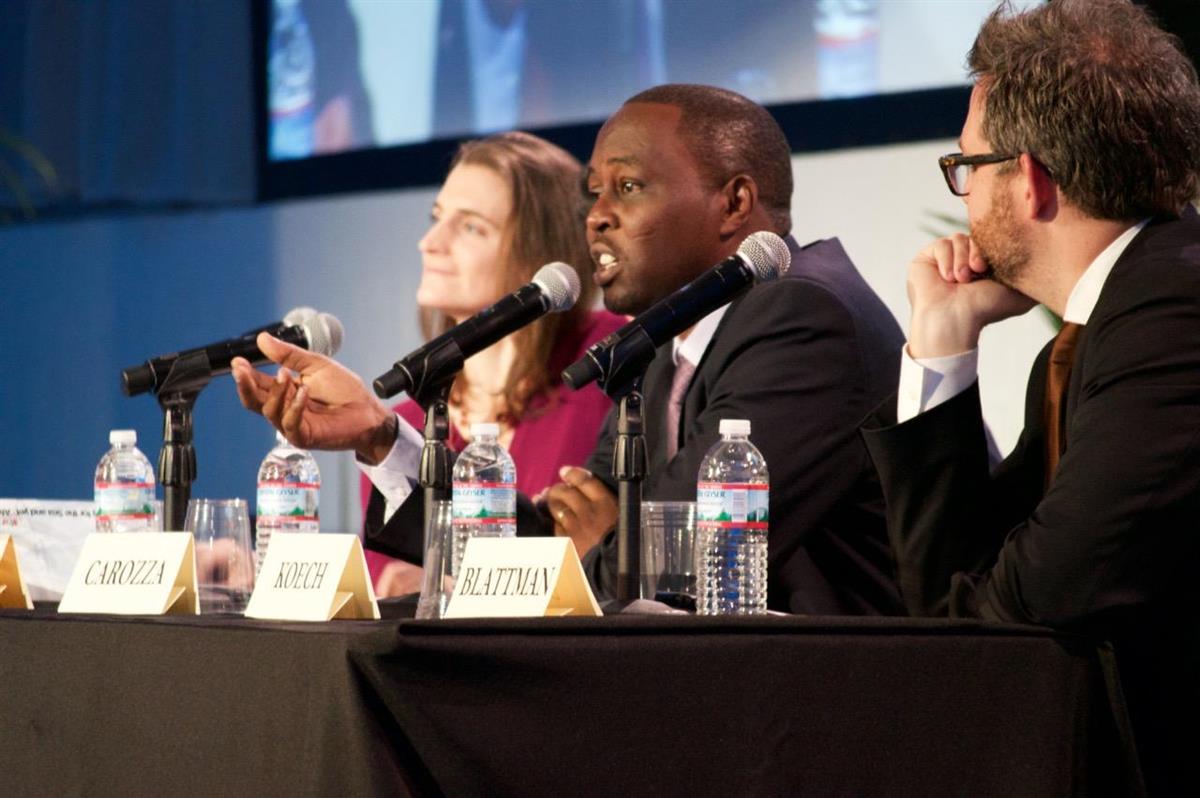
More than 300 people had the opportunity to visit the exhibit “Generating Beauty: New Beginnings at the Ends of the World”. Over 500 people attended the panel organized in partnership with the New York Encounter around the theme “The Quest to Reduce Extreme Poverty: Current Trends in International Development”.
During the three days of the Encounter, hundreds more stopped by at a booth to learn about AVSI's projects around the world: this year more than $2,000 was raised in donations in exchange for hand-made bags, necklaces, bracelets, earrings and iron plates fashioned in Mexico, Uganda and Haiti.
Jackie Aldrette, Managing Director of AVSI-USA, reports that, “New York Encounter 2016 was an intense weekend full of many encounters with old friends and new contacts from all walks of life. All of our activity was united by a common theme: attempts at supporting human development, reducing poverty and improving well-being are endeavors which engage all of our human experience and require a humble approach that has authentic relationships and a ‘gaze' on the infinite dignity of the other person and of oneself as the primary mode. The enthusiasm of so many people to engage with our work in some way was invigorating!”
Coming to the US for the first time, after being presented in Italy and Switzerland, the exhibit sponsored by AVSI-USA, “Generating Beauty: New Beginnings at the Ends of the World”, was one of the highlights of this year's New York Encounter. Curated by acclaimed Irish journalist John Waters, the exhibit shows the impact of AVSI's projects in three locations: Ecuador, Kenya and Brazil. In these places, AVSI built projects with an educative method which places the development of the person at its center. During the New York Encounter, visitors could explore 19 panels illustrating these three different realities together with a short video from each country: a group of schools in Nairobi, Kenya, a center for nutritional education in São Paulo, Brazil, a new form of early childhood education in the suburbs of Quito, Ecuador. In addition, visitors could also join one of 15 guided tours throughout the weekend.
Joakim Koech, Principal of Cardinal Maurice Otunga High School in Nairobi, Kenya, came to the US for the first time and was present for the opening night of “Generating Beauty”.
“Look at this image”, said Koech, pointing to the exhibit poster which depicts a boy wearing a bright orange tie and a blue shirt, in contrast with the Kibera slum in the background. “This image is a very good representation of our work at Otunga High School. Through Giussani's method and thanks to AVSI, we show our students that despite the fact that they were born and still live in a slum, they can learn, grow and have a better future.”
Mr. Koech was also invited to join the panel “The Quest to Reduce Extreme Poverty: Current Trends in International Development” alongside Jackie Aldrette (Managing Director, AVSI-USA) and Chris Blattman (Professor of Political Science, Columbia University). With Paolo Carozza (Director of the Kellogg Institute at Notre Dame University) as moderator, the panel invited the speakers to discuss what was behind their personal and professional commitment to the field of international development, what they learned from success and failure, and how they have been able to persevere, despite the challenges.
“I had trained as a teacher, but after college, I didn't want to teach because I thought it was too little. I wanted to be rich,” said Mr. Koech, followed by a burst of laughter. “What I learned as a teacher and thanks to Giussani's method is that it makes a big difference when you look at a person, in our case our students, and you tell them they are worth it. I'm growing, my students are growing, my teachers are growing, this method is working.”
Researcher for entities including J-PAL and Innovations for Poverty Action, Dr. Blattman described an AVSI program that gave funds to women who live in extreme poverty, in Northern Uganda. AVSI put fewer constraints and imposed much less oversight than such programs typically involve and, despite Dr. Blattman initial skepticism, it was successful.
“Approaches like this may require a great deal of humility. We have to be willing to put our trust in people,” said Dr. Blattman.
After the initial responses, Dr. Carozza asked a question about the dynamics of risk and human freedom in addressing poverty. In her answer, Jackie Aldrette described her experience with observing what happens when we bet first on the freedom of the people themselves and of the local organizations that respond to extreme poverty.
“What we have learned is that our best bet is to invest in people that come from local communities and organizations,” said Aldrette.
In addition to the exhibit and panel, AVSI also set up a promotional booth that became a reference point for visitors and supporters from across the US, who wanted to learn more about the organization's projects and activities around the world. Staff and volunteers collected donations in exchange for hand-made bags fashioned by the women of Crecemos in Oaxaca, Mexico, necklaces and bags made by women from Meeting Point International in Kampala, Uganda, and bags, iron plates and bracelets designed and produced in Haiti. In total, over $2,000 was raised and will go directly to support projects at these organizations and countries, in the coming months.